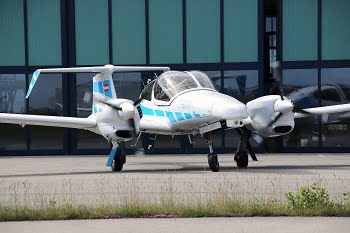MUNICH, July 8, 2019 — Automatic landings have been commonplace in commercial aviation for some time, and they help pilots touch down safely at large airports. Smaller airports are often not equipped with the ground-based systems that help planes land, which means that adverse conditions, such as low visibility, can challenge pilots. To help overcome these challenges, researchers have turned to optics and new software to allow for automatic landings that do not require ground-based systems.

Modified research aircraft Diamond DA42 of the research project C2Land of the Technical University of Munich and the Technical University of Braunschweig. Courtesy of Andreas Dekiert.
Giving GPS a hand
For the German government-supported project called C2Land, researchers from the Technical University of Munich and the Technical University of Braunschweig created a new vision-assisted navigation system that employs two cameras: one camera in the visual spectrum and another in the IR range, which provides data in limited visibility conditions.
The system does not rely solely on cameras, however. Autopilot systems use GPS to navigate, which in the air is fine, but the instrument’s susceptibility to measurement inaccuracies from atmospheric disturbances makes them a liability when landing.
The C2Land project’s software takes in data from GPS and then makes corrections based on data taken in from its cameras. The system then calculates a virtual glide path for the landing.
In late May, the team put the system to the test. Test pilot Thomas Wimmer took the helm and made a completely automatic landing at the Diamond Aircraft airfield in Wiener-Neustadt.
“The cameras already recognize the runway at a great distance from the airport,” Wimmer said. "The system then guides the aircraft through the landing approach on a completely automatic basis and lands it precisely on the runway’s centerline."